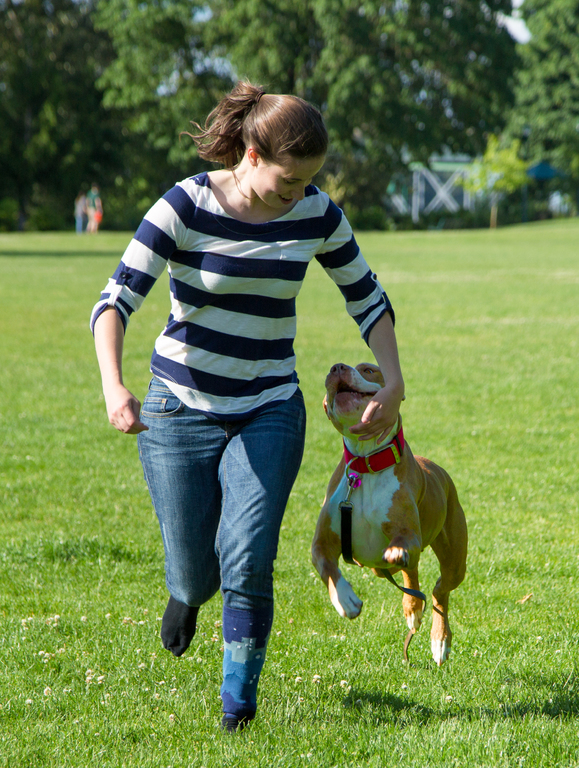When your dog barks, it's like deciphering a cryptic code that reveals their inner thoughts and feelings. Curious about why your furry companion engages in this vocal behavior? Understanding the underlying motivations behind your dog's barks can provide valuable insights into their world.
From alerting you to potential dangers to expressing their needs and emotions, each bark carries a distinct message. Unravel the mystery behind this common canine behavior to strengthen your bond and enhance your communication with your four-legged friend.
Key Takeaways
- Dogs bark to communicate fear, alertness, frustration, attention needs, and discomfort.
- Reinforcement and training play essential roles in shaping and controlling barking behavior.
- Consistency, alternative behavior teaching, distractions, and positive reinforcement can reduce excessive barking.
- Seek professional help for persistent barking, considering underlying medical conditions and training for effective communication.
Reasons for Dog Barking
Why do dogs bark?
Dogs bark for various reasons, such as fear, anxiety, stress, alerting to perceived threats, frustration, seeking attention, or expressing pain.
When a dog barks out of fear or anxiety, it may be due to storm phobia, noise phobia, separation anxiety, or the presence of strangers.
Alert barking occurs when dogs want to warn their family about potential threats like people or other dogs passing by.
Frustration barking can happen when they're unable to reach something, like a squirrel.
Seeking attention through barking is common when they want to play, get petted, go outside, or come back in.
Additionally, barking can also be a way for dogs to communicate discomfort or pain.
Understanding Canine Fear and Anxiety
To understand canine fear and anxiety, observe your dog's body language and vocalizations for signs of distress. Here are some key indicators to look out for:
- Body Language: Watch for signs like cowering, trembling, tucking the tail between the legs, or trying to hide.
- Vocalizations: Listen for whining, whimpering, or excessive barking that's high-pitched or frantic.
- Avoidance Behaviors: Notice if your dog tries to escape or avoids certain situations or people.
- Destructive Behaviors: Pay attention to any destructive actions like chewing furniture or excessive licking.
Understanding these cues can help you identify when your dog is feeling fearful or anxious, allowing you to provide support and comfort as needed.
Alerting Family to Perceived Threats

Dogs instinctively alert their families to perceived threats by barking loudly and persistently. This behavior stems from their natural protective instincts, signaling potential danger and ensuring everyone is aware of possible risks.
When your dog perceives a threat, whether it's a stranger approaching the house or another animal in the vicinity, they vocalize to communicate the need for attention and vigilance. Responding to your dog's alert barking by investigating the cause can help strengthen the bond between you and reassure your pet that their warnings are being acknowledged.
Understanding and respecting this form of communication can enhance your dog's sense of security and reinforce their role as a valued member of your family.
Managing Frustration in Dogs
When managing frustration in dogs, it's important to recognize signs of distress and implement effective strategies to address and alleviate their emotional state. Here are some tips to help you manage your dog's frustration:
- Provide Mental Stimulation: Engage your dog with puzzle toys or interactive games to keep their mind occupied and prevent boredom.
- Offer Physical Exercise: Regular walks, play sessions, or agility training can help release pent-up energy and reduce frustration.
- Create a Safe Space: Give your dog a quiet, comfortable area where they can retreat when feeling overwhelmed or frustrated.
- Use Positive Reinforcement: Reward calm behavior and ignore or redirect signs of frustration to encourage positive responses.
Seeking Attention and Interaction

For dogs seeking attention and interaction, engaging in interactive play sessions can be a beneficial way to fulfill their social needs and strengthen the bond between you and your furry companion. When your pup barks to get your attention, it's their way of saying, "Let's interact!" By responding positively to their cues, you reinforce their behavior and create a positive cycle of communication. Below is a table highlighting key ways to engage with your dog when they seek attention:
| Activities | Description | Benefits |
|---|---|---|
| Interactive play sessions | Engage in play with toys or games | Provides mental stimulation |
| Training sessions | Teach new tricks or commands | Promotes learning |
| Quality time together | Cuddle, pet, or simply be present | Strengthens bond |
Expressing Pain or Discomfort
If your furry companion is expressing pain or discomfort, it's essential to observe their behavior closely for any signs of distress. Here are some key indicators to help you identify if your dog is in pain or discomfort:
- Changes in Body Language: Watch for tense body posture, ears pinned back, or reluctance to move.
- Vocalizations: Whimpering, yelping, or excessive barking may signal pain.
- Decreased Appetite or Activity: A decrease in eating or reluctance to engage in activities they usually enjoy.
- Aggression or Irritability: Unusual aggression or irritability towards you or other pets may indicate discomfort.
If you notice any of these signs, it's important to consult with your veterinarian to address your dog's pain or discomfort promptly.
The Role of Reinforcement in Barking

To understand why reinforcement plays a crucial role in shaping a dog's barking behavior, it's important to recognize how dogs respond to positive stimuli. Dogs are motivated by rewards and attention, making reinforcement a powerful tool in training and behavior modification.
When a dog barks and receives attention or a treat, it reinforces the behavior, making the dog more likely to bark in similar situations in the future. Controlling or eliminating this reinforcement can help curb excessive barking.
Continuous reinforcement further strengthens the barking behavior, emphasizing the need for consistent training methods focused on positive reinforcement.
Importance of Behavior Shaping
Understanding the importance of behavior shaping is key in effectively modifying your dog's barking habits. Here are some key points to consider:
- Consistency: Ensure that you're consistent in your training approach and expectations.
- Positive Reinforcement: Use rewards and positive reinforcement techniques to encourage desired behaviors.
- Patience: Changing behavior takes time, so be patient and persistent in your training efforts.
- Clear Communication: Clearly communicate what behaviors are acceptable and provide clear cues for when barking isn't appropriate.
Controlling and Eliminating Reinforcement

Control and eliminate reinforcement to effectively address your dog's barking behavior.
| Control Reinforcement | Eliminate Reinforcement |
|---|---|
| Ignore the barking | Avoid giving attention |
| Walk away or leave the room | Remove the source of barking |
| Use a neutral tone of voice | Do not scold or shout |
| Provide attention when calm | Stay consistent |
Training Techniques for Barking
When addressing your dog's barking behavior, implementing effective training techniques is essential for promoting positive changes in their communication habits. To help you train your dog to bark less, consider the following techniques:
- Positive Reinforcement: Reward your dog for staying quiet when they'd typically bark.
- Desensitization: Gradually expose your dog to triggers that cause barking, rewarding calm behavior.
- Training Commands: Teach your dog commands like 'quiet' or 'enough' to control barking.
- Consistency: Be consistent in your training efforts to reinforce the desired behavior and discourage excessive barking.
Strategies to Stop Excessive Barking

To address excessive barking in your dog, implementing effective training strategies is key to promoting quieter behavior. Consistency is crucial in managing your expectations and teaching your dog appropriate behaviors.
Avoid situations that trigger barking and provide distractions when needed. Positive reinforcement techniques, such as rewarding quiet behavior, can help in reducing excessive barking.
Teaching your dog alternative behaviors to replace barking, like sitting or fetching a toy, can also be beneficial. Remember to remain patient and understanding during the training process.
Seeking Professional Help
Consider seeking professional help if your dog's barking persists despite your efforts to address it using training strategies. Professional intervention can provide specialized guidance and support tailored to your dog's specific needs. Here are some reasons why seeking professional help is beneficial:
- Expertise: Trained professionals can assess your dog's behavior accurately.
- Customized Solutions: They can create a personalized behavior modification plan for your dog.
- Behavioral Therapy: Professionals can offer advanced techniques to address complex barking issues.
- Medical Evaluation: They can help rule out underlying medical conditions contributing to excessive barking.
Don't hesitate to reach out for professional assistance to ensure the well-being of your furry companion.
Understanding Dog Communication Through Barking

If your dog's barking behaviors continue despite your training efforts, understanding how dogs communicate through barking can provide valuable insights into their needs and emotions. Dogs use barking as a way to express a range of emotions and messages. By paying attention to the context and nuances of your dog's barks, you can better understand what they are trying to communicate. Here's a breakdown of different types of barks and their potential meanings:
| Bark Type | Meaning |
|---|---|
| Alert Barks | Warning about possible danger |
| Playful Barks | Expressing joy and excitement |
| Aggressive Barks | Signaling threat or territorial behavior |
| Distress Barks | Indicating discomfort or fear |
| Boredom Barks | Seeking stimulation or attention |
Effective Communication to Reduce Barking
Improving communication with your dog can be key to reducing excessive barking behaviors. Here are some tips to help you effectively communicate with your furry friend:
- Establish Clear Signals: Use consistent cues and body language to convey messages to your dog.
- Provide Mental Stimulation: Engage your dog in activities that challenge their mind and reduce boredom.
- Reward Desired Behavior: Use positive reinforcement to encourage quiet behavior and reinforce good habits.
- Seek Professional Guidance: If barking issues persist, consider consulting a professional trainer or behaviorist for personalized advice and support.
Is Excessive Barking a Sign of a Larger Issue in Dogs?
Excessive dog barking behavior analysis is crucial to identifying underlying issues. It could indicate stress, anxiety, or boredom. Health problems or lack of training may also contribute. Seek professional help to address the root cause and improve your dog’s well-being and behavior.
Conclusion
Now that you have a better understanding of why dogs bark, you can work towards fostering a harmonious relationship with your furry friend.
By recognizing the various reasons behind their vocalizations and implementing effective communication and training techniques, you can address excessive barking and encourage positive behaviors.
Remember to be patient and consistent in your approach, and seek professional help when needed.
With clear communication and understanding, you can strengthen the bond with your beloved companion.




